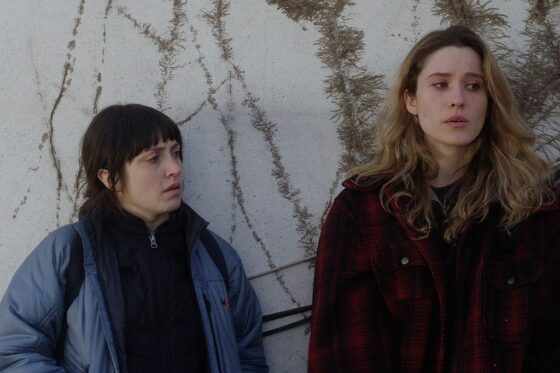Stage Fright: Dan Sallitt’s Fourteen

By Anna Swanson
Early in Dan Sallitt’s Fourteen, best friends Mara (Tallie Medel) and Jo (Norma Kuhling) briefly compare their contrasting opinions on fancy lingerie. Mara says that she doesn’t like to wear it because it makes her feel like she’s in a play; Jo’s quick response is to question what’s so wrong about being in a play. The two easily shrug off the difference of opinion and move on, but this minor disagreement not only gives evidence of the rift that has begun to form between them, but also speaks to how Fourteen effectively straddles naturalism and theatricality. While the film’s shoestring budget, lo-fi aesthetic, and palpable sense of intimacy largely align it with the former, it also features scenes where the characters do indeed seem as if they’re in a play, moments where the predominant naturalism shades over into slightly outlandish details. However, it’s a testament to Sallitt’s keen but unobtrusive skill as a dramatist—which is all the more impressive considering that he has roughly averaged one completed feature per decade since the 1980s, in between his pursuits as a critic, noted cinephile, screenwriter, Twitter presence, and actor (in Matías Piñeiro’s Hermia & Helena [2016])—that these more heightened beats are made to serve the film’s overall subdued tone, rather than the prevailing calm setting up the moments of storm.
Sallitt’s previous and most acclaimed feature, The Unspeakable Act (2012), earned him frequent comparisons to Éric Rohmer in his character-driven narratives keyed to minor but meaningful acts of introspection, his sharply written dialogue, and the stripped-down visuals that ensure there are no distractions from these exchanges. Continuing in that vein, in Fourteen Sallitt places the focus on what Mara and Jo say to one another and sometimes, even more importantly, what they don’t say. The two women have been friends since they were 14 years old, but adulthood has put a strain on the mutual devotion left over from middle school. Mara is a few years out of university, working as a teacher’s aide and writing fiction on the side. She’s creative, but practical; she views teaching not just as a day job but as a possible career path, even though she clearly evinces a desire for recognition when an old college friend speaks to her about her writing. Jo, by contrast, is offbeat and impulsive, perpetually moving onto the next thing and relying on Mara as the sole stabilizing force in her life. With her statuesque appearance and comic energy, Kuhling gives Jo the vibe of a Greta Gerwig-type character—particularly in a wonderful sight gag where Jo, carrying on a conversation with Mara as they walk down the street, breaks off mid-sentence to dart into a bakery and grab a brownie.
If Mara is the character that is the best representative of the film’s naturalism, Jo is its theatrical complement, prone to impassioned outbursts that counteract the understated dispositions of those around her, and indeed of the film itself. While Mara does not lack for her own struggles in life, she contends with them by looking inward rather than lashing out. She appreciates stability and routine; emotional outbursts are as rare as the indulgence of lingerie. And as she settles into the person she’s meant to become, Mara finds it difficult to relate to Jo’s dramatics and unpredictability—particularly since, as becomes apparent, Jo’s troubles extend beyond typical quarter-life-crisis restlessness. Her mental health has been a source of difficulty for as long as Mara has known her, and her attempts to find peace with herself have been unsuccessful. She has bouts of erratic, manic behaviour interspersed with feelings of defeat; she’ll frantically call Mara, begging her to come over, only to be asleep in bed and unwilling to get out once Mara arrives.
While it becomes clear that Mara and Jo’s bond is becoming progressively more frayed, Sallitt is wisely uninterested in building towards a breaking point. Rather than any catastrophic, overacted blowout, he more realistically charts the gap that slowly forms between his protagonists as they first go for a few days without being in touch, then a few weeks, then a few months, during which time Mara acquires a full-time teaching position and a long-term boyfriend, while Jo’s mental health continues to prevent her from holding down a steady job. As Sallitt’s editing becomes increasingly elliptical, with ever greater amounts of time bridged between sequences, Fourteen becomes less of a straightforward narrative and more of a series of brief vignettes that, increasingly, track Mara’s progress while largely eschewing Jo. What Jo is doing and how she’s coping is often as much a mystery to us as it is to Mara—an all-too-believable depiction of the slow fade by which we can gradually lose the bonds that united us another lifetime ago. There are third-act revelations in Fourteen that, while not unrealistic, are a touch jarring given the film’s determinedly unsensational demeanour. However, they are also crucial in calling into question Mara’s progression towards a commonly agreed upon (and thus inherently questionable) idea of “maturity.” The highs and lows that come with living life like a play inevitably catch up with Jo, but even as Mara has moved away from her, she cannot fully shake the effect that Jo’s unpredictable passions had upon her life. For someone resistant to the idea of living in a play, Mara now has to contend with the problem of mounting herself a one-woman show.
Anna Swanson

